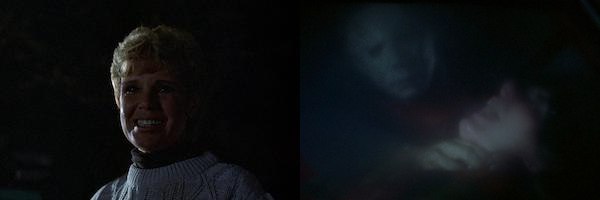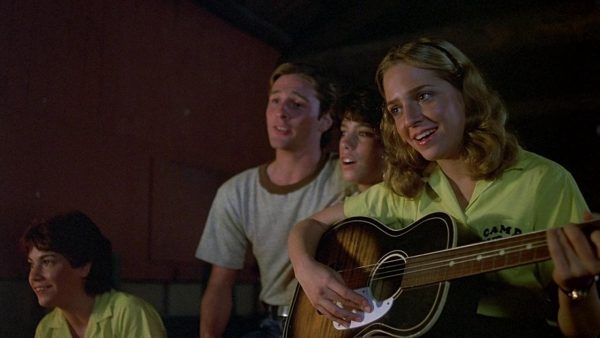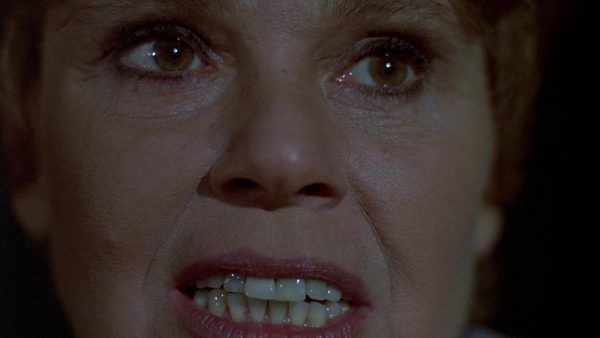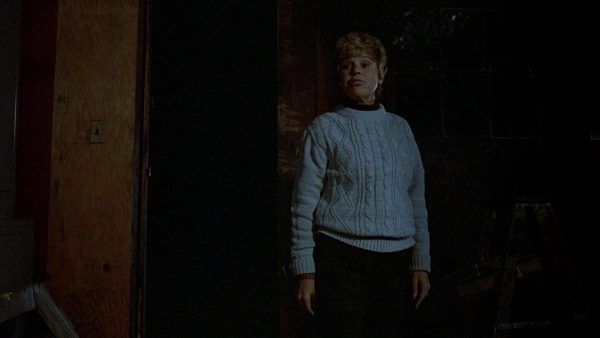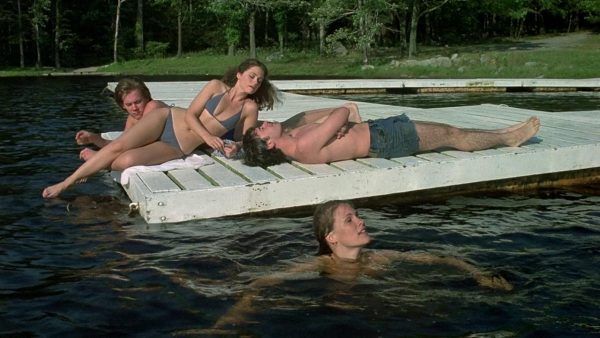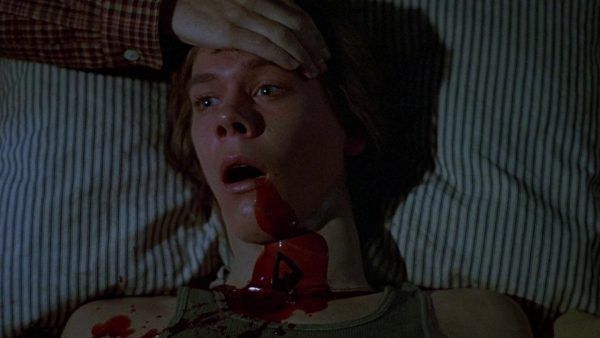I know, it's blasphemy. One of these films literally invented the template of slasher horror, instantly became an iconic hit, and made its impression in pop culture at large in a number of demonstrable ways. The other is a shameless rip-off of the first one, a cliché-ridden grab-bag of horny teens meeting their comeuppance, and its resulting franchise's primary influence upon pop culture didn't even appear in it. And yet -- I have always found Friday the 13th to be the superior slasher film to Halloween.
I am not here to bury Halloween, but to praise it. It remains an engine of dread. A showpiece of low-budget ingenuity. A firework of a calling card for screen icons like John Carpenter, Debra Hill, Donald Pleasence, and of course Jamie Lee Curtis. It works, man! But, especially when screened one after the other, I think Friday the 13th works even better -- both in the facets that make it explicitly dissimilar, and in the similar thematic choices Halloween tries to make.
I've visited both Haddonfield and Camp Crystal Lake, and I'm here to explain why the latter is the scarier spot. With apologies to Mr. Myers, whom I would desperately like to not come visit me and hide behind my laundry, this is why Friday the 13th is better than Halloween.
Warning: Spoilers for both Friday the 13th and Halloween to follow.
The Prologue Sets Up Clearer Stakes
Halloween begins with one of the most celebrated shots in all of horror cinema. From the vantage point of a young Michael Myers (to the point where, as Myers puts on a Halloween mask, so too does the camera's vision become obscured by a mask over the lens), we stalk a young couple in the middle of getting freaky -- the woman happening to be his older sister, Judith Myers. But when little Michael Myers is driven to a frenzied madness by what he's viewing, he pulls out a knife and stabs them relentlessly to death. It's a harrowing shot -- a showpiece of cinematography that forces us, in a sickly piece of voyeuristic confirmation of our basest impulses, to align with a killer. It also prepares us for the purity of cruelty in store for the rest of the film.
Friday the 13th... well, I'm not gonna lie, it pretty much cribs the "opening tracking shot from the killer's perspective" move from Halloween. But its opening moments aren't solely constructed around this one shot. In fact, director Sean S. Cunningham is more than willing to use liberal use of a standard third-person omniscient camera to align us not just with the killer, but with the humanity of the eventual victims -- and this more standard method of filmmaking coverage sets up and specifies the "rules" with clarity and efficiency.
We see what I might call "the most wholesome teens ever" around a campfire, literally singing Christian songs. But two teens sneak away to go get freaky, and as fate would have it, this is who our first-person killer cam follows and kills. As a result, the viewer knows exactly what kind of behavior our killer can tolerate, and what kind of behavior our killer must destroy. It gives the rest of the film an understandable road map and, ironically given Halloween's cinematic technique, a stronger point of view from our killer. Granted: Halloween's opening also seems to communicate that Myers can't tolerate "freaky shenanigans from teens who are supposed to be watching young children," but by branching out to a more versatile set of tools, Friday the 13th crystallizes the point. Crystallizes -- like Camp Crystal Lake! That's kinda fun, right?
Anyway, speaking of "a stronger point of view from our killer," let's fast-forward to the ending right quick.
The Villain's Revelation and Humanity Are More Effective
Jason Voorhees, the hockey-mask wearing, machete-wielding psychopath we all know and love from Friday the 13th, ain't in Friday the 13th. Er, well, he kind of is. We see him briefly as a young boy drowning, and in a jump scare for the ages, his emaciated and decomposing corpse jumps at final girl Alice (Adrienne King) in a dream sequence near the end. But the iconography we all know as "Jason" does not appear in the first film, and he is certainly not the killer. Who is? His mother: Pamela Voorhees, played in a barn-burning performance by Betsy Palmer.
In Halloween, there's no such trickery involved with the villain's revelation. We know who he is throughout. The characters use his name explicitly throughout. But I'm not talking about "Michael Myers." I'm talking about "the bogeyman." Myers' lack of humanity is a given, even in his credited name as "The Shape" (played with lumbering concern by legend Nick Castle). His doctor, Sam Loomis (Pleasence) insists to anyone who'll listen that there is no human being left behind his mask. When we do briefly see Myers' mask come off (with Tony Moran's face), he quickly and panic-strickenly puts it back the hell on, so desperate he is to not be a person, but a mythical force of terror and carnage. And when Laurie Strode (Curtis) tells Dr. Loomis straight up "he was the bogeyman," Dr. Loomis does not correct her. Instead, he says, "As a matter of fact, it was." It's not just a symbolic description -- according to Loomis, it is an objective fact. This all speaks very well to the ultimate thematic conclusions of the film. Raw terror and fear cannot be explained by the constraints of humanity. It's beyond our understanding, always existing, never fully vanquished. It's the bogeyman. And "you can't kill the bogeyman."
It's eerie stuff, meant to get in our guts and fester and rot. And intellectually, I find the idea of "an unknowable faceless bogeyman" to be appropriately scary and stimulating. But for me, because there is by design no humanity to have a gut feeling in reaction to, these types of terrors feel too cerebral. Carpenter communicates this existential terror with masterful filmmaking, yes, but I can't help but appreciate it at arm's length, like a piece of austere art in a museum. Friday the 13th, on the other hand, puts an identifiable human face with an identifiable human motivation at the center of its horrors. And this choice hits me where I live even harder -- because if this normal-seeming woman could make the choice to kill, what if I could be compelled to, too?
Throughout the film, we never see the killer -- only occasional use of that first-person POV camera, and the gruesome results of their doings. Now, because of my sociological knowledge of serial killers (not just in film but in real life) and the context of "Jason Voorhees, horror icon," my initial assumption (and, I believe, the intention of Cunningham's film) was that the killer was a man. From a pure nuts-and-bolts narrative standpoint, the twist that it's actually a middle-aged woman hits me right in the dang gut. And when she explains herself -- her son Jason drowned because the camp counselors were getting sinfully freaky instead, and she's out to get justice for her poor little boy -- it hits me right in the dang heart. And then, when she starts to reveal just how deeply mad she has gone (wow, does Palmer sell her rapid-fire transitions from speaking as Pamela to "speaking as Jason"), my head starts to fire neurons like crazy, worrying that this fate could befall me one day.
In giving its villain such a powerhouse twist and such explicit humanity, Friday the 13th hits me more than Halloween. Plus, it reminds me -- alongside the film's beautiful and underrated mixed-genre score (classical Herrmann strings clashing against bizarre synth tones; Carpenter's work is obviously iconic but Harry Manfredini deserves just as much credit) -- of one Mr. Alfred Hitchcock, particularly Psycho. Yes, I just called Friday the 13th a Hitchcockian film. That's kinda fun, right?
The Performances Feel More Authentic
Even the goths and emo-pop-punk scene kids I grew up with had more vitality than the teens in Halloween. Granted, a sense of muted, repressed energy is to be expected from our heroine Laurie, who we're told prefers babysitting and studying to going out and getting freaky with her fellow teens. But the other teens in the picture, gifted with the runway to get into shenanigans, smoke pot in the car, and yes, get freaky, can't rise above stilted, overly performative, unfortunately wooden line readings. Halloween is a low-budget piece of filmmaking, a damn fine one at that, but its performances can't help but read creaky upon modern light. And when Pleasence, a veteran actor at this point, arrives in the film and gives his Dr. Loomis 110%, it results in a performance that sticks out like a sore thumb, an overly theatrical take that feels, especially compared to the lack of emotion felt from the other actors, like it's from a different movie.
Not so in Friday the 13th. From moment one, the teens feel alive, crackling with warm. believable, even charming energy. Our core group of kids at Camp Crystal Lake (including Kevin Bacon!) are a genuine pleasure to watch -- there's a Richard Linklater hangout movie about doofy city teens trying to get by in the woods embedded into this slasher film. And because we're so charmed by these authentic performances, and we feel their natural rapport before the horrors start occurring, it gives us stronger emotional stakes to these characters once they do. Yes, they're sinning teens getting freaky when they should be protecting each other, but we still care about them, and it hurts in the gut to see them get dispatched. Whereas in Halloween, it feels like a plot-driven inevitability.
Case in point: After the opening credits, we follow Annie Phillips (Robbi Morgan) on a hitchhiking journey to Camp Crystal Lake, and we immediately like her. She's bright, she's bubbly, she's optimistic, she gets about as literal of a "save the cat" moment as you'll see in horror cinema (well, she attends to a dog, but still). Obviously, she is our heroine we'll be following through this journey, right? Dead wrong. As in, the moment she's dropped off near the camp, she is stalked and slashed by the killer. And this misdirect absolutely walloped me. Even though we had only gotten to know her for a few minutes, Morgan's inviting performance combined with the crisp, fundamental screenwriting resulted in a balance-discombobulating scare that set the tone not just for the film's scares to come, but for the genuine affection you'll feel for the people they happen to.
And speaking of "the film's scares," my final point:
The Kills and Scares Are Way Gnarlier
Halloween is masterful at conveying dread. The images that stick with me aren't when Myers actually explicitly stabs folks to death, but the lingering, still moments and implicit threats of stabbing folks to death. Myers staring at Laurie a little too far away outside of her school. Myers slightly hidden behind some air-drying laundry. Myers wearing a ghost sheet and glasses. Hell, the film's final images of still houses manage to instill dread. When Carpenter actually tightens the screws and gets to Myers' stabbing, however, the tension immediately pops. I can't help but find these moments to feel forced and even unintentionally funny; when our first person camera in the prologue literally pans to the knife stabbing down, I understand the horror Carpenter's trying to communicate (a young child learning the joys of killing!), but it plays with unfortunate ham-fistedness. It's telling that the most effective kill in the film is the one where Myers strangles Annie Brackett (Nancy Kyes) in the backseat of the car, as it's framed with purposeful obfuscation. Lensed through the foggy lens of the car window, Myers' shape is barely visible, playing perfectly into the film's sense of dread and insidious everywhere-ness of evil.
Not so with Friday the 13th. The kills are loud, front, and center. And they still pack a ferocious, guttural punch. I'm a fella who's seen a lot of violent horror films, but the kills and scares in Friday the 13th shook me more than a damn New French Extremity picture. Partially, it's because of their frank explicitness -- I'm very fond of Carpenter's subtlety and nuance, but damn, sometimes a horror flick needs to shove an arrow through Kevin Bacon's throat in gory detail to make its point, and the point is heard. Partially, it's because I care so much more about these characters, vis-a-vis their chemistry, authenticity, and likeability. And finally, while Carpenter remains one of my favorite all-time directors and his work on Halloween is obviously masterful, we must give praise Cunningham's underrated work here, too.
One scare sequence, in particular, strikes me as a near-perfect "tension build and cathartic release" piece of filmmaking, that I dare say rivals and even bests any Carpenter Halloween scare. Marcie Stanler (Jeannine Taylor), who has just had sex with Jack Burrell (Bacon), heads to the bathroom. After our killer makes with the arrow-shoving re: Jack, she stalks Marcie to get her next. Suspense is stretched, noises are heard, Marcie suspects the worse -- until nothing happens. "Just my imagination," concedes Marcie to herself -- right as, behind her, we see the shadow of an ax fall. It's beautifully classic and (again) Hitchcockian filmmaking, its use of light and shadow intertwining brilliantly with dramatic irony to give us nothing but dread.
And then: We see the axe fall into her face in gnarly, gory, grim detail, providing this moment of tension-building with a world-shatteringly bleak climax. Halloween prepares you a cake and tells you the idea of the cake existing is enough. Friday the 13th prepares you a cake and lets you eat it, both parts satisfying in equal measure.
For this, when it comes to Voorhees Vs. Myers, my vote will always be with the poor family who suffered so dearly at Camp Crystal Lake.

